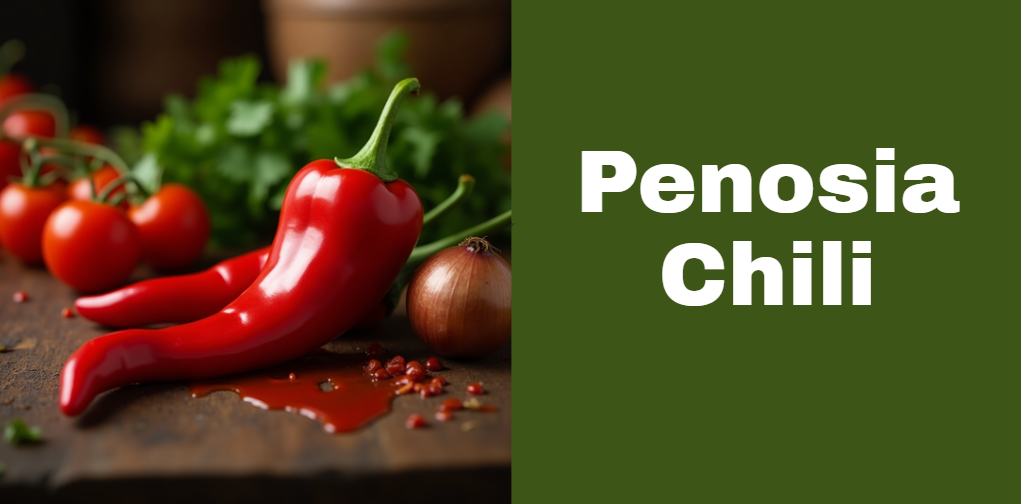Penosia Chili: A Complete Guide to Its Origins, Uses and Health Benefits
Penosia chili, a unique and flavorful variety of chili pepper, has begun making waves across the globe. Known for its vibrant color, moderate heat, and complex taste, this chili is gaining popularity among chefs, home cooks, and spice enthusiasts alike.
Whether you’re an experienced cook looking for a new ingredient to experiment with, or simply someone curious about the chili’s background and benefits, this guide will provide a comprehensive look into all things related to Penosia chili.
In this article, we will explore the origins of Penosia chili, its distinctive characteristics, culinary applications, health benefits, and more. By the end, you’ll have a deep understanding of this exciting pepper and how it can be a valuable addition to your kitchen.
Origins and Cultivation of Penosia Chili
Native Regions and Historical Background
Penosia chili traces its roots to the rich soils and warm climates of Central and South America, where chili peppers have been cultivated for centuries. Indigenous cultures in these regions have long incorporated chilies into their diets, not only for their heat but also for their rich flavors and medicinal properties. Penosia chili, like other varieties, thrives in the temperate highland regions of countries like Mexico, Guatemala, and parts of the Andes.
Over time, Penosia chili has found its way into different cuisines, becoming an essential element in traditional dishes like salsas, soups, and sauces. Its versatility has contributed to its growing popularity worldwide, making it a sought-after ingredient in kitchens across continents.
Cultivation and Growth Conditions
Penosia chili plants flourish in well-drained, fertile soil that is rich in organic matter. These plants require plenty of sunlight, with temperatures ranging from 70°F to 90°F (21°C to 32°C) for optimal growth.
The chili thrives in regions with moderate rainfall and is typically grown at higher altitudes, where the cooler temperatures allow for a more nuanced flavor development.
Harvesting and Quality Control
Once the chili peppers reach maturity, they are carefully hand-picked to ensure the best quality. The harvest usually occurs after the chilies have turned a deep red color, which is a sign of ripeness. The best Penosia chilies are harvested at the peak of their flavor, ensuring they retain their natural sweetness and smokiness, even after drying or processing.
Botanical Characteristics of Penosia Chili
Penosia chili peppers are medium-sized and have a distinctive, elongated shape that tapers to a point. Their skin is smooth, with a bright red hue that deepens as the pepper matures. The interior is filled with a moderate amount of seeds and the flesh, though slightly thick, is known for its tender texture when cooked.
Varietal Differences
While there is a general standard for Penosia chili, there are a few regional variations that can differ in terms of heat levels, color intensity, and flavor profiles. These differences are often influenced by the growing conditions, such as soil composition and altitude.
Flavor Profile and Heat Level
Taste Nuances: A Unique Combination of Heat, Sweetness, and Smokiness
The Penosia chili stands out for its balanced flavor profile, combining both heat and sweetness. The heat level, while significant, is not overwhelming, making it an ideal chili for people who want to add spice without burning their taste buds. It has a rich, earthy undertone with a hint of smokiness, which makes it versatile in both cooked and raw dishes.
Scoville Heat Units (SHU) and Comparison with Other Chilies
Penosia chili generally falls within a heat range of 1,000 to 250,000 Scoville Heat Units (SHU), depending on its growing conditions. This places it somewhere between mild and hot chili peppers, making it an excellent choice for those looking to experiment with chili heat but not exceed the threshold of intense spiciness like habanero or ghost pepper.
| Chili Pepper | Heat Level (SHU) |
|---|---|
| Penosia Chili | 1,000 – 250,000 |
| Jalapeño | 3,500 – 8,000 |
| Habanero | 100,000 – 350,000 |
| Ghost Pepper | 1,000,000+ |
Culinary Applications of Penosia Chili
Fresh Usage
One of the most popular ways to enjoy Penosia chili is by using it fresh. Its firm texture and vibrant color make it perfect for incorporating into salsas, guacamole, and fresh salads. The sweet heat complements tomatoes, onions, and cilantro in salsas, providing a unique kick to your favorite Mexican or Latin dishes.
Dried and Powdered Forms
Dried Penosia chilies are perfect for creating spice blends, rubs, and marinades. Once dried, the chilies can be ground into a fine powder that can be sprinkled over meat, vegetables, or even in soups and stews. The smoky flavor deepens when dried, making it an excellent addition to savory dishes.
Cooked Dishes
Penosia chili’s versatility extends to cooked dishes, where it adds a warm, full-bodied heat to soups, stews, and chilis. The chili is often simmered to release its natural oils and flavors, enriching the broth of your dish. It also pairs beautifully with both meat and vegetarian recipes, adding depth and heat without overpowering the other ingredients.
Innovative Uses
In more creative culinary applications, Penosia chili has found its way into desserts like chocolate truffles or spicy ice creams, where its heat balances the sweetness. It can also be infused into oils or used in cocktails, offering a spicy kick to beverages such as margaritas or bloody marys.
Health Benefits of Penosia Chili
Penosia chili is not just a flavorful addition to your meals—it also offers several health benefits. Like many other chili peppers, Penosia chili contains capsaicin, the compound responsible for its heat. Capsaicin has been shown to boost metabolism, promote fat burning, and improve circulation.
Nutritional Content
In addition to capsaicin, Penosia chili is rich in vitamins, particularly vitamin A and vitamin C. These nutrients play a crucial role in supporting the immune system, improving skin health, and acting as powerful antioxidants.
Metabolic and Digestive Benefits
Capsaicin also aids digestion by stimulating the production of gastric juices and improving the body’s ability to break down food. Some studies suggest that consuming capsaicin-rich foods may help reduce symptoms of indigestion and promote gut health.
Anti-Inflammatory Properties
Capsaicin is known for its anti-inflammatory effects, which can help alleviate pain and reduce swelling. It is commonly used in topical creams for pain relief, particularly for conditions like arthritis.
Growing Penosia Chili at Home
If you’re interested in growing Penosia chili yourself, here’s what you need to know:
Planting and Care
Penosia chili can be grown in both pots and garden beds. Start seeds indoors in early spring and transplant them outdoors once the risk of frost has passed. Ensure the plants receive plenty of sunlight and are watered regularly but not over-saturated.
Pest and Disease Management
While Penosia chili is relatively hardy, it can be susceptible to pests like aphids and spider mites. Regularly inspect the plants for signs of infestation and use organic methods such as neem oil or insecticidal soap to manage pest populations.
Preservation and Storage
Penosia chili can be preserved in several ways. Drying is one of the most common methods, as it extends the pepper’s shelf life while intensifying its flavor. Chilies can also be pickled, frozen, or preserved in oil. Store dried chilies in airtight containers in a cool, dry place to maintain their flavor and potency.
Global Influence and Cultural Significance
Across many cultures, chili peppers hold a place of importance both in the kitchen and in cultural practices. Penosia chili is no exception. From its origins in Central and South America to its presence in contemporary cuisines, it plays a role in both traditional and modern dishes.
Conclusion
Penosia chili is a remarkable ingredient that offers more than just heat—it adds depth, flavor, and versatility to your dishes. Whether you’re using it fresh, dried, or powdered, Penosia chili can elevate your cooking and provide significant health benefits. From its cultural history to its modern-day applications, this chili is sure to become a favorite in your kitchen.
Recommended Articles
Fashion Junkee Shirt TheyEnvyus – Complete Guide to Style, Quality & Trends
AWT69X Technology: Full Guide to Features, Architecture, Applications & Future
Orannalaura: A Comprehensive Guide to Its Meaning, Influence and Multifaceted Role in Modern Culture
Understanding and Resolving the “Cloudlin Down ETH1” Network Interface Issue






